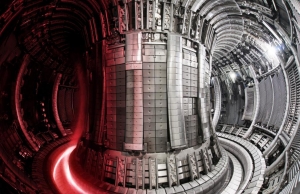JET: a record fusion energy of deuterium and tritium
09-02-2022
An international team of scientists working on the largest working JET tokamak (Oxford, UK) reported a record energy of 59 MJ achieved during a deuterium-tritium fusion lasting 5 seconds. NCBJ researchers contributed to the JET program through detector upgrades and plasma analysis. In Świerk, research is also carried out on materials that may be used in thermonuclear installations.
At a press conference held at the Culham Center for Fusion Energy (CCFE), UK, they announced a record 59 megajoules of energy obtained during a 5-second fusion at the Joint European Torus (JET) tokamak operating in Culham near Oxford. This is the first time that such high energy was obtained during the fusion reaction of deuterium and tritium over a few seconds. Experts see this as a milestone in mastering fusion and using it as a clean energy source. Although the balance of energy supplied and obtained is still not positive (this was not what the creators of JET had expected), the result will be of great importance for the ITER device being built in France. Scholars expect that there, for the first time, it would be possible to demonstrate the operation of an installation producing ten times more energy than needed. The next step is to build a DEMO fusion reactor showing the full potential of nuclear fusion as a potential commercial energy source.
The role of NCBJ in the work on the JET tokamak and research for thermonuclear fusion:
NCBJ participated in the modernization of gamma radiation detectors in the energy range from a few to a dozen or so MeV. In the modernized detectors, fast scintillators were used, which in systems with modern electronics and a data collection system allow for measurements that enable the registration of over a million events per second. Upgraded scintillation detectors were used in the gamma spectrometer and the gamma camera. The modernization of gamma radiation detectors was carried out by the team of the Department of Electronics and Detection Systems NCBJ.
NCBJ scientists are also analyzing the gamma and X-ray spectra of the plasma structures of the JET tokamak, on the basis of which the key plasma parameters are determined. The works are carried out at the Department of Nuclear Apparatus and Techniques.
The NCBJ research program also includes, among others research on new materials that can be used in fusion reactors. We reported on the design of the probe, thanks to which new materials could be tested in the neutron flux of traditional reactors (https://www.ncbj.gov.pl/aktualnosci/reaktor-maria-wspiera-badania-synte…) and research on tungsten – the basic material for the construction of many elements of the installation (https://www.ncbj.gov.pl/aktualnosci/niezwykle-precyzyjne-obliczenia-str…).
Other useful materials, such as ODS steels, are tested by the Materials Research Laboratory of the NCBJ Materials Research Department and by scientists from our NOMATEN research agency.
A complete set of information on the JET result:
https://www.euro-fusion.org/news/2022/european-researchers-achieve-fusi…
Full conference on YouTube: https://www.youtube.com/watch?v=H99hvPlC4is





